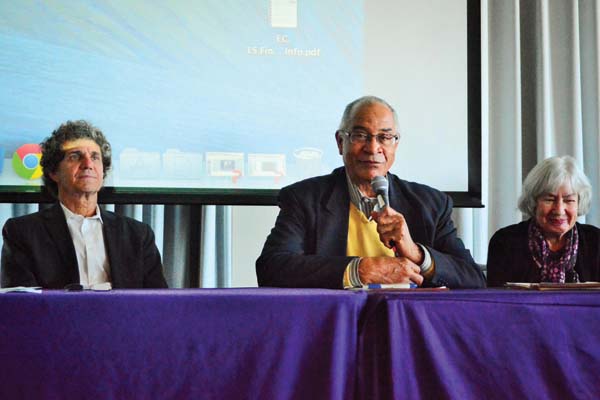Panel discusses Martin Luther King Jr.’s influence in North Shore housing discrimination issues

Lauren Duquette/The Daily Northwestern
Activist Bennett Johnson discusses school integration at a panel sponsored by the Center for Civic Engagement. The event, held in Norris University Center, focused on the issue of discriminatory housing practices in the Chicago area during the 20th century.
April 29, 2015
More than 50 years after Martin Luther King Jr. turned down a job offer from the Garrett-Evangelical Theological Seminary to continue his work in the South, a panel of local community members discussed King’s influence on the civil rights movement in Chicago and Evanston.
“I’ve started on this challenging venture of love and nonviolence and I am all too aware of the fact that this philosophy has not been spread enough in the Deep South,” King wrote in his letter to the seminary, which is located on Northwestern’s campus.
The letter was one of the documents shared Tuesday afternoon at an event commemorating King’s 1958 speech at the Technological Institute and the 50th anniversary of his visit to the Winnetka Village Green, where he spoke about housing discrimination.
The event, hosted by the Center for Civic Engagement and local organization Open Communities, consisted of presentations by Open Communities’ executive director Gail Schechter and NU archivist Kevin Leonard as well as a panel with activists David Borris, Bennett J. Johnson and Nina Raskin.
Schechter discussed Chicago’s role in the civil rights movement and said although the South was dealing with the issue of voter registration, the North Shore Summer Project was dealing with issues of open housing and discriminatory practices.
The NSSP operated from 1965 to 1966 to uncover housing restrictions in the Chicago and North Shore areas that prevented black families from buying houses in otherwise white neighborhoods.
“In 1965 you could discriminate, you could have listings that said no Negroes, no Jews, no Orientals,” Schechter said. “The summer project was fighting against that.”
Schechter said a group of white women in the early 1960s was concerned about the housing situation in the North Shore and began investigating why homeowners wouldn’t sell their homes to black families.
Years later, the NSSP discovered most homeowners didn’t care who bought their properties, but realtors wouldn’t sell houses to black families. Although it took three years for fair housing to become part of North Shore law, NSSP efforts helped further this cause.
“Northwestern was very much part of the North Shore Summer Project, providing technical assistance, something I think the school should be proud of,” Schechter said.
During the panel discussion, Nina Raskin, one of the coordinators of the Evanston Freedom Center branch of the NSSP and a participant in the 1965 Selma marches, said after moving to Evanston with her husband in 1957 she was surprised to see how segregated the community was.
Raskin, a fair housing activist, participated in marches, surveys about racial issues in Evanston and became an advocate for school integration. After living in Glencoe for 37 years, Raskin just moved back to Evanston.
“It’s very interesting to me to see the contrast from what I left and the community now,” she said. “It’s really wonderful to see, to experience and to have lived through that change. I do have hope for the future, but there’s a tough battle ahead.”
Bennett J. Johnson, longtime civil rights activist, shared his experience working with the integration of the Evanston school system. He said the key to change happened after schools were integrated and people became more politically active and progressive.
The final panelist, David Borris, president of Chicago Area Peace Action, spoke about Open Communities’ 2015 Justice Project, which aims to become a grassroots 21st-century social justice movement.
The project, which Borris said will discuss the more radical views King had, will kick off a five-year project in July aiming to share conversations about today’s civil rights issues across communities, younger generations and people who may be unaware of today’s race issues.
“It’s not on them to go out there and find all the problems,” Borris said. “But it is on us to put in front of them the conversation and ask them a simple question: ‘What does a just and welcoming community mean to you?’”
Pearl Hirshfield, a community member who participated in the 1965 Selma marches with Raskin, said the event brought back many memories.
“I was on the bus with them to the South,” she said. “The first thing I remember, coming in to the South was people, young people on trees yelling at us and spitting and then we walked through the black areas and the people there came out bringing us food and love as we were marching. We have a lot of memories of that trip.”
Kerry Brown, Center for Civic Engagement program assistant, said CCE thought it would be important to bring the 2015 Justice Project closer to campus. She mentioned the Baltimore protests that began Monday in reaction to the death of Freddie Gray, a 25-year-old African-American man who died in police custody, as evidence that society still faces racial issues.
“I would like students to think about how things that we’re seeing today, literally today in Baltimore, but over the last couple of years in terms of race relations in the United States, how these aren’t new issues,” she told The Daily. “It’s important to get a historical perspective and see and appreciate how far we’ve come but also see how much further there is to go.”
Email: [email protected]
Twitter: @marianaa_alfaro

